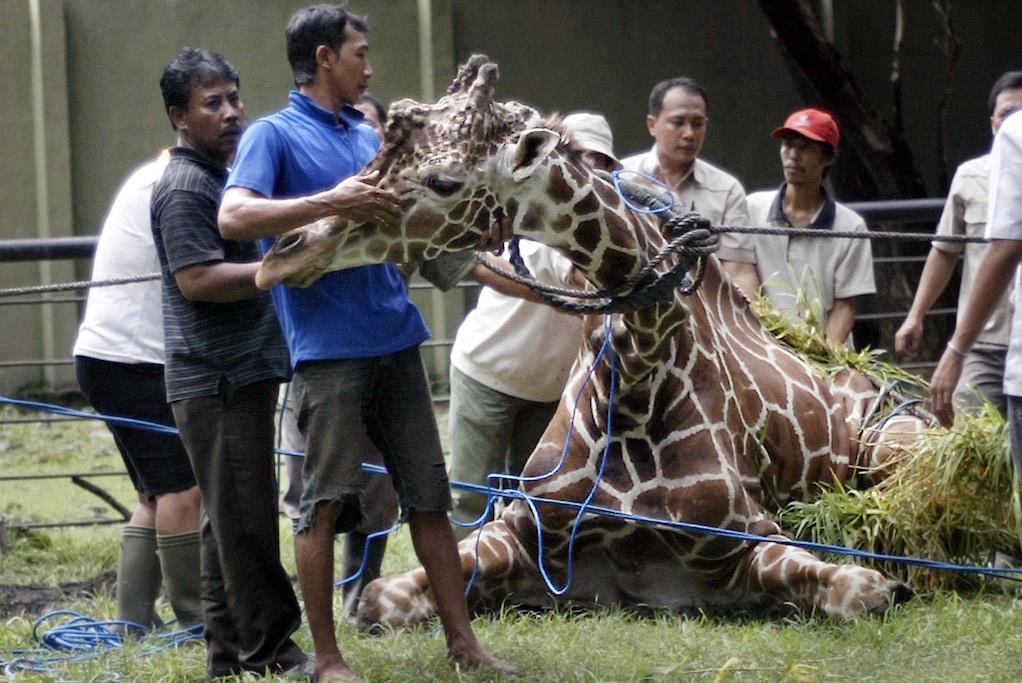For endangered wildlife, this Indonesian zoo can be akin to a death sentence
Indonesian zoo personnel attend to a 30-year-old ailing giraffe named Kliwon at the Surabaya zoo in Surabaya, on March 1, 2012. The giraffe died that evening with 20 kilograms of plastic found in its stomach.
JAKARTA, Indonesia — Surabaya Zoo is famous across the world. Not for being the oldest and biggest zoo in Indonesia, nor because of its large and diverse collection of rare species.
No, the reason Surabaya Zoo has been making international headlines is that its animals keep on dying.
In January, an 18-month-old lion was found dead in its cage, hanging by its head from an errant piece of metal wire. Since then, an African gnu and a Komodo dragon have died from stomach disorders, and a mountain goat from a fight with another goat. A rare Bengal tiger is undergoing treatment, and a barking deer and a rare midget buffalo have also perished.
Overall, zoo officials say more than 100 animals have died since July.
The situation has sparked international condemnation. An online petition calling for the zoo to be shut down has gathered 200,000 signatures. The marketing department would have a hard time finding promotional quotes in the media. “Zoo of death,” “nightmare zoo,” “world’s cruelest zoo,” “national shame” — that’s how journalists have described it.
Yet the zoo management doesn’t seem especially worried, and rejects accusations of unprofessionalism.
Calling the number of fatalities “acceptable,” “normal” and “in line with regulations,” it denies any wrongdoing. Apparently to inoculate against further criticism, it also recently warned that another 80 old or sick animals will die in the near future.
In fact, the zoo director, Ratna Achjuningrum, actually implied the animals had only themselves to blame for their deaths. Some were hurt “because of their own mistakes,” such as “being hyperactive” and “fighting among each other,” she reportedly said.
She did not mention whether the zoo planned to hold knitting workshops to reduce hyperactivity, or mandate anger management classes for the violent goats.
The zoo in Surabaya, Indonesia’s second biggest city, was built under Dutch colonial rule more than 100 years ago. It houses some 3,500 animals, including many endangered species such as Sumatran tigers and Borneo orangutans.
Experts and visitors describe animals living in pitiful conditions: dirty, neglected and over-crowed. There are skin-and-bones tigers and camels, elephants with their legs chained, pelicans in cramped cages.
After years of battle over the management of the zoo, the Surabaya city administration has officially been in charge of the facility since July. Agus Supangkat, the zoo's spokesperson, argues things are getting better. He says the zoo is undergoing a board and staff reshuffle, and has started receiving much needed government funding since the city took over. "We are renovating the facilities and building about 50 new enclosures, and we're no longer giving animals water from the city's river," he says. The zoo is also discussing managerial partnerships with US, Britain, and China zoos in order to improve animal welfare.
But some fear letting politicians take over won’t put an end to the ongoing misery.
Tony Sumampau, the head of Indonesia’s Zoo Association, is very familiar with Surabaya Zoo. He led a caretaker team there before the city took over. He can go on and on about what’s wrong with it. Overcrowded, inadequate or tainted food, facilities dating from the Dutch time, lack of data management, and more than anything, lack of competent staff.
“We keep on telling them what to do but they don’t understand that they need experts in wildlife conservation, zoologists … there are no professionals there at the moment,” he says, arguing city officials were not qualified to run a zoo.
Jan Schmidt-Burbach, a senior wildlife and veterinary adviser at the World Society for the Protection of Animals, says his organization is very concerned with what’s happening in Surabaya, but stresses the situation is not specific to this zoo, and not even to Indonesian zoos. He reports limited funding, lack of resources and unqualified zookeepers resulting in sub-adequate standards all across Asia.
But he says there is no excuse for not taking simple steps that demand more common sense than wildlife expertise, such as making sure the public doesn’t throw garbage into enclosures. Two years ago, a giraffe was found dead in Surabaya zoo with more than 40 pounds of plastic in its stomach. For years it had been eating litter thrown into its pen.
He also laments that too many administrators in the region confuse their zoos with circuses.
“Showing an orangutan displaying circus tricks or a macaque riding around on a tricycle does nothing for conservation of animals or education of the visitors, it’s pure entertainment,” he says.
In Indonesia’s Taru Jurug zoo, an orangutan was moved away from the public in 2012. It had been smoking cigarettes thrown into its cage by visitors eager to snap funny photos.
In Surabaya and despite international outrage, the city is still confident the zoo “will attain an international standard,” as the mayor put it last September. In the meantime, a welfare assessment by international zoo animal experts that was supposed to take place in February has yet to be approved by the city.
The story you just read is accessible and free to all because thousands of listeners and readers contribute to our nonprofit newsroom. We go deep to bring you the human-centered international reporting that you know you can trust. To do this work and to do it well, we rely on the support of our listeners. If you appreciated our coverage this year, if there was a story that made you pause or a song that moved you, would you consider making a gift to sustain our work through 2024 and beyond?
